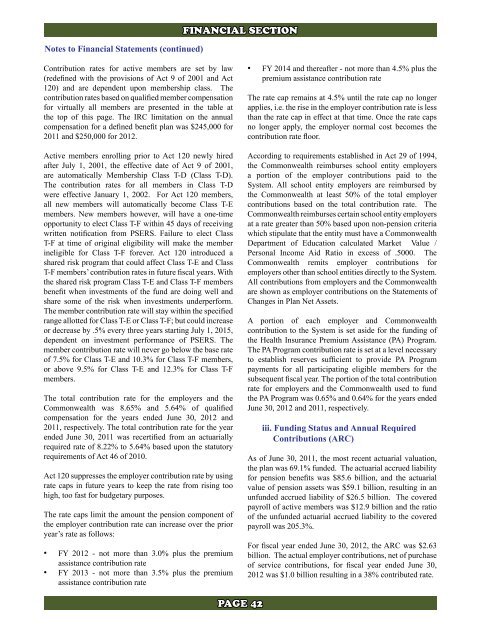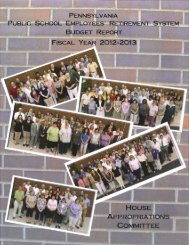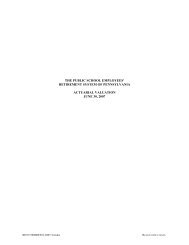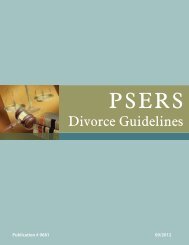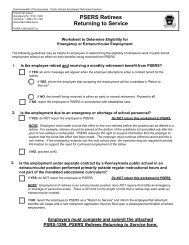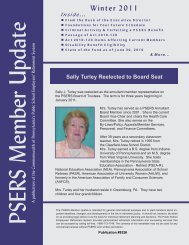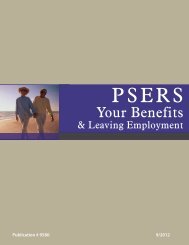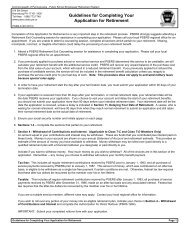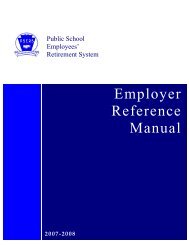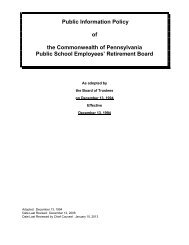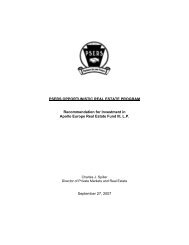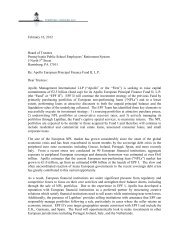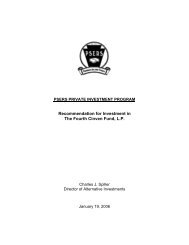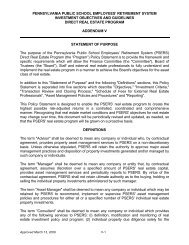a complete copy of the 2012 CAFR Report! - PSERs
a complete copy of the 2012 CAFR Report! - PSERs
a complete copy of the 2012 CAFR Report! - PSERs
Create successful ePaper yourself
Turn your PDF publications into a flip-book with our unique Google optimized e-Paper software.
Notes to Financial Statements (continued)<br />
FINANCIAL SECTION<br />
Contribution rates for active members are set by law<br />
(redefined with <strong>the</strong> provisions <strong>of</strong> Act 9 <strong>of</strong> 2001 and Act<br />
120) and are dependent upon membership class. The<br />
contribution rates based on qualified member compensation<br />
for virtually all members are presented in <strong>the</strong> table at<br />
<strong>the</strong> top <strong>of</strong> this page. The IRC limitation on <strong>the</strong> annual<br />
compensation for a defined benefit plan was $245,000 for<br />
2011 and $250,000 for <strong>2012</strong>.<br />
Active members enrolling prior to Act 120 newly hired<br />
after July 1, 2001, <strong>the</strong> effective date <strong>of</strong> Act 9 <strong>of</strong> 2001,<br />
are automatically Membership Class T-D (Class T-D).<br />
The contribution rates for all members in Class T-D<br />
were effective January 1, 2002. For Act 120 members,<br />
all new members will automatically become Class T-E<br />
members. New members however, will have a one-time<br />
opportunity to elect Class T-F within 45 days <strong>of</strong> receiving<br />
written notification from PSERS. Failure to elect Class<br />
T-F at time <strong>of</strong> original eligibility will make <strong>the</strong> member<br />
ineligible for Class T-F forever. Act 120 introduced a<br />
shared risk program that could affect Class T-E and Class<br />
T-F members’ contribution rates in future fiscal years. With<br />
<strong>the</strong> shared risk program Class T-E and Class T-F members<br />
benefit when investments <strong>of</strong> <strong>the</strong> fund are doing well and<br />
share some <strong>of</strong> <strong>the</strong> risk when investments underperform.<br />
The member contribution rate will stay within <strong>the</strong> specified<br />
range allotted for Class T-E or Class T-F; but could increase<br />
or decrease by .5% every three years starting July 1, 2015,<br />
dependent on investment performance <strong>of</strong> PSERS. The<br />
member contribution rate will never go below <strong>the</strong> base rate<br />
<strong>of</strong> 7.5% for Class T-E and 10.3% for Class T-F members,<br />
or above 9.5% for Class T-E and 12.3% for Class T-F<br />
members.<br />
The total contribution rate for <strong>the</strong> employers and <strong>the</strong><br />
Commonwealth was 8.65% and 5.64% <strong>of</strong> qualified<br />
compensation for <strong>the</strong> years ended June 30, <strong>2012</strong> and<br />
2011, respectively. The total contribution rate for <strong>the</strong> year<br />
ended June 30, 2011 was recertified from an actuarially<br />
required rate <strong>of</strong> 8.22% to 5.64% based upon <strong>the</strong> statutory<br />
requirements <strong>of</strong> Act 46 <strong>of</strong> 2010.<br />
Act 120 suppresses <strong>the</strong> employer contribution rate by using<br />
rate caps in future years to keep <strong>the</strong> rate from rising too<br />
high, too fast for budgetary purposes.<br />
The rate caps limit <strong>the</strong> amount <strong>the</strong> pension component <strong>of</strong><br />
<strong>the</strong> employer contribution rate can increase over <strong>the</strong> prior<br />
year’s rate as follows:<br />
• FY <strong>2012</strong> - not more than 3.0% plus <strong>the</strong> premium<br />
assistance contribution rate<br />
• FY 2013 - not more than 3.5% plus <strong>the</strong> premium<br />
assistance contribution rate<br />
• FY 2014 and <strong>the</strong>reafter - not more than 4.5% plus <strong>the</strong><br />
premium assistance contribution rate<br />
The rate cap remains at 4.5% until <strong>the</strong> rate cap no longer<br />
applies, i.e. <strong>the</strong> rise in <strong>the</strong> employer contribution rate is less<br />
than <strong>the</strong> rate cap in effect at that time. Once <strong>the</strong> rate caps<br />
no longer apply, <strong>the</strong> employer normal cost becomes <strong>the</strong><br />
contribution rate floor.<br />
According to requirements established in Act 29 <strong>of</strong> 1994,<br />
<strong>the</strong> Commonwealth reimburses school entity employers<br />
a portion <strong>of</strong> <strong>the</strong> employer contributions paid to <strong>the</strong><br />
System. All school entity employers are reimbursed by<br />
<strong>the</strong> Commonwealth at least 50% <strong>of</strong> <strong>the</strong> total employer<br />
contributions based on <strong>the</strong> total contribution rate. The<br />
Commonwealth reimburses certain school entity employers<br />
at a rate greater than 50% based upon non-pension criteria<br />
which stipulate that <strong>the</strong> entity must have a Commonwealth<br />
Department <strong>of</strong> Education calculated Market Value /<br />
Personal Income Aid Ratio in excess <strong>of</strong> .5000. The<br />
Commonwealth remits employer contributions for<br />
employers o<strong>the</strong>r than school entities directly to <strong>the</strong> System.<br />
All contributions from employers and <strong>the</strong> Commonwealth<br />
are shown as employer contributions on <strong>the</strong> Statements <strong>of</strong><br />
Changes in Plan Net Assets.<br />
A portion <strong>of</strong> each employer and Commonwealth<br />
contribution to <strong>the</strong> System is set aside for <strong>the</strong> funding <strong>of</strong><br />
<strong>the</strong> Health Insurance Premium Assistance (PA) Program.<br />
The PA Program contribution rate is set at a level necessary<br />
to establish reserves sufficient to provide PA Program<br />
payments for all participating eligible members for <strong>the</strong><br />
subsequent fiscal year. The portion <strong>of</strong> <strong>the</strong> total contribution<br />
rate for employers and <strong>the</strong> Commonwealth used to fund<br />
<strong>the</strong> PA Program was 0.65% and 0.64% for <strong>the</strong> years ended<br />
June 30, <strong>2012</strong> and 2011, respectively.<br />
iii. Funding Status and Annual Required<br />
Contributions (ARC)<br />
As <strong>of</strong> June 30, 2011, <strong>the</strong> most recent actuarial valuation,<br />
<strong>the</strong> plan was 69.1% funded. The actuarial accrued liability<br />
for pension benefits was $85.6 billion, and <strong>the</strong> actuarial<br />
value <strong>of</strong> pension assets was $59.1 billion, resulting in an<br />
unfunded accrued liability <strong>of</strong> $26.5 billion. The covered<br />
payroll <strong>of</strong> active members was $12.9 billion and <strong>the</strong> ratio<br />
<strong>of</strong> <strong>the</strong> unfunded actuarial accrued liability to <strong>the</strong> covered<br />
payroll was 205.3%.<br />
For fiscal year ended June 30, <strong>2012</strong>, <strong>the</strong> ARC was $2.63<br />
billion. The actual employer contributions, net <strong>of</strong> purchase<br />
<strong>of</strong> service contributions, for fiscal year ended June 30,<br />
<strong>2012</strong> was $1.0 billion resulting in a 38% contributed rate.<br />
PAGE 42


